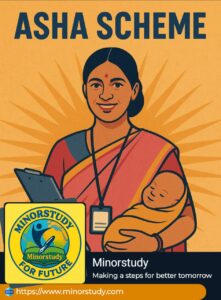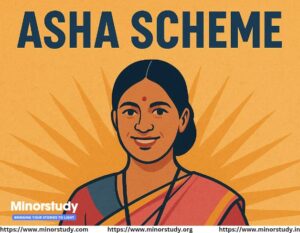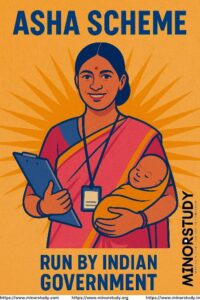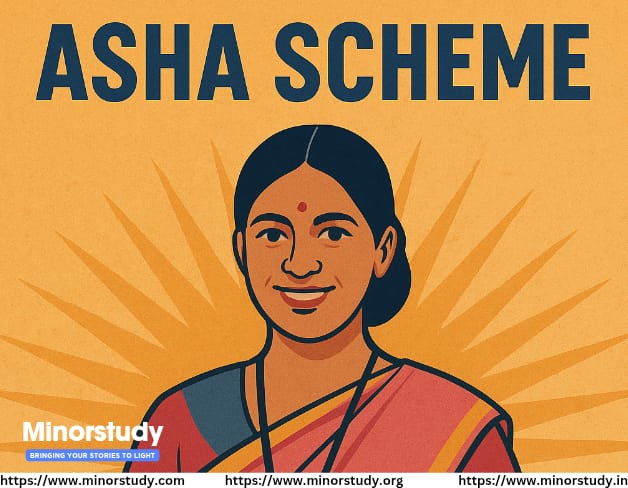All You Need to Know About the ASHA Scheme: History, Significance, FAQs, and Its Life-Changing Impact
ASHA Scheme: In the vast and vibrant land of India, where villages often lie miles away from a clinic or doctor, there exists a silent force of women making healthcare accessible: the ASHA workers. The ASHA Scheme, launched by the Government of India, is one of the most impactful community health worker programs in the world.
- 📖 What is the ASHA Scheme?
- 🕰️ History and Timeline of the ASHA Scheme
- 🌟 Why Is the ASHA Scheme So Significant?
- 1. Healthcare in the Last Mile
- 2. Maternal and Child Care
- 3. Disease Surveillance
- 4. Community Empowerment
- 5. Women Empowerment
- 💡 9 Eye-Opening Facts About the ASHA Scheme
- 🤔 Frequently Asked Questions (FAQs)
- ❓ Who can become an ASHA worker?
- ❓ Are ASHAs government employees?
- ❓ What kind of training do ASHAs receive?
- ❓ How are ASHAs paid?
- ❓ Do they have career growth?
- ❤️ Real-Life Importance of ASHA Workers in Our Daily Lives
- 🎊 Observance and Public Recognition
- 🎁 How to Wish or Honor an ASHA Worker
- 💬 Important Points to Remember
- 🧭 Conclusion: A Scheme That Touches Lives Silently But Powerfully
But who are these ASHAs? What makes this scheme so significant? Let’s explore the journey, contributions, and life-changing impact of ASHA workers across India—through a human lens.
📖 What is the ASHA Scheme?
ASHA stands for Accredited Social Health Activist. The ASHA Scheme is a part of India’s National Rural Health Mission (NRHM), launched in 2005 by the Ministry of Health and Family Welfare.
The core idea is simple yet powerful: select a local woman from each village, train her, and empower her to act as a bridge between the health system and the community.
She isn’t a doctor. She isn’t a nurse. But she is the first point of contact for healthcare in rural India.

🕰️ History and Timeline of the ASHA Scheme
| Year | Milestone |
|---|---|
| 2005 | ASHA Scheme launched under the National Rural Health Mission (NRHM) |
| 2010 | Role expanded to urban areas under the National Urban Health Mission (NUHM) |
| 2013 | Formation of National Health Mission (NHM) by merging NRHM and NUHM |
| 2017 | ASHAs integrated into various national programs like TB, family planning, and NCD screening |
| 2020 | ASHAs declared frontline COVID-19 warriors |
| 2021 | Awarded the Global Health Leaders Award by the WHO |
| 2022 | Over 1 million ASHAs working across India |
| 2023 | Government enhanced incentives and recognized ASHA contributions in official policy updates |
🌟 Why Is the ASHA Scheme So Significant?
1. Healthcare in the Last Mile
ASHAs work in remote corners where hospitals are often hours away. They ensure that no mother or child is left behind when it comes to basic health services.
2. Maternal and Child Care
ASHAs help with antenatal checkups, institutional deliveries, immunizations, and nutrition counseling—crucial for reducing maternal and infant mortality.
3. Disease Surveillance
From malaria to tuberculosis, and more recently, COVID-19, ASHAs are the eyes and ears of India’s public health system.
4. Community Empowerment
They educate, guide, and counsel families on topics like family planning, hygiene, breastfeeding, and managing chronic conditions.
5. Women Empowerment
The scheme provides employment and respect to over 1 crore women (10 million), transforming social dynamics in villages.
💡 9 Eye-Opening Facts About the ASHA Scheme
Over 1 million ASHA workers are currently active across rural and urban India.
Each ASHA typically covers a population of about 1000 in rural areas.
ASHAs are selected from within their own communities—making them trusted.
They are not salaried employees; they receive performance-based incentives.
On average, an ASHA earns between ₹2,000 to ₹6,000/month, depending on activities.
They are involved in 70+ health-related tasks, including birth registration and home visits.
ASHAs walked hundreds of kilometers during COVID-19 lockdowns to spread awareness and ensure health coverage.
WHO recognized India’s ASHA workers in 2022 for their exceptional community service.
ASHAs play a key role in Ayushman Bharat, PM-JAY, and other government health initiatives.

🤔 Frequently Asked Questions (FAQs)
❓ Who can become an ASHA worker?
Any married/widowed/divorced woman aged 25–45, preferably with formal education up to Class 8 and from the same village or locality.
❓ Are ASHAs government employees?
No. They are community health volunteers who receive task-based honorariums instead of a fixed salary.
❓ What kind of training do ASHAs receive?
ASHAs undergo 23 days of modular training, spread across multiple phases, covering topics like maternal care, child health, sanitation, contraception, and first aid.
❓ How are ASHAs paid?
ASHAs earn through incentives for each activity:
₹300–₹600 per institutional delivery,
₹100 for polio rounds,
₹500 for TB patient follow-up,
₹200–₹300 per sterilization case facilitated,
and so on.
❓ Do they have career growth?
While limited, some ASHAs have been promoted to ASHA Facilitators, Supervisors, or have entered the formal health workforce through further studies and experience.
❤️ Real-Life Importance of ASHA Workers in Our Daily Lives
A pregnant woman in a tribal hamlet gets iron tablets and ultrasound referrals, thanks to the ASHA.
A family learns about safe drinking water practices, preventing diarrhea outbreaks.
A child receives full immunization on time, guided by the ASHA.
A couple learns about birth control options and spacing children.
During COVID-19, ASHAs were the first to inform, monitor, and even test suspected cases in remote areas.
They are not just workers—they are often the only lifeline to health awareness and services in India’s remotest villages.
🎊 Observance and Public Recognition
While there’s no official ASHA Day, their contributions are recognized during:
National Health Mission Days
International Women’s Day (March 8)
World Health Day (April 7)
POSHAN Maah (Nutrition Month in September)
In some states, ASHAs receive annual awards, felicitations, and performance-based recognitions by local governments or NGOs.

🎁 How to Wish or Honor an ASHA Worker
You can express gratitude with simple yet meaningful messages:
🌺 “You are the heartbeat of village healthcare. Thank you for being a true hero!”
🙏 “Because of you, our children smile healthy and our mothers stay safe. We honor your selfless service.”
🌸 “To every ASHA worker – your steps lead to healthier lives. Salute to your courage and care!”
Better still, advocate for:
Better pay
Health insurance
Regular training
Community appreciation programs
💬 Important Points to Remember
ASHAs are volunteers, not employees.
Their work covers maternal care, vaccinations, sanitation, family planning, and community health education.
They are crucial in times of public health emergencies like COVID-19.
Recognition is growing, but they still need policy-level protections and permanent pay structures.
🧭 Conclusion: A Scheme That Touches Lives Silently But Powerfully
The ASHA Scheme is more than a public health initiative—it’s a lifeline, a beacon of care, and a symbol of women’s empowerment in India. These women may not wear stethoscopes or sit in air-conditioned clinics, but they save lives in the most grassroots and human ways imaginable.
They walk through fields, knock on doors, sit with the elderly, counsel young mothers, and hold newborns with compassion. They do it all, often with little recognition, low income, and high risk.
India’s healthcare system, especially in rural belts, would collapse without them.
So the next time you hear the term “ASHA worker,” remember—you’re hearing about a real-life heroine quietly changing the nation’s health landscape.









ini adalah situs bokep
Thanks a bunch for sharing this with all of us you really understand
what you’re speaking approximately! Bookmarked. Kindly also
visit my web site =). We will have a link change agreement between us
Simply want to say your article is as surprising. The clearness to your put up is simply nice and that i could think you’re an expert on this subject.
Fine along with your permission let me to grasp your
RSS feed to stay up to date with coming near near post.
Thank you 1,000,000 and please keep up the enjoyable
work.